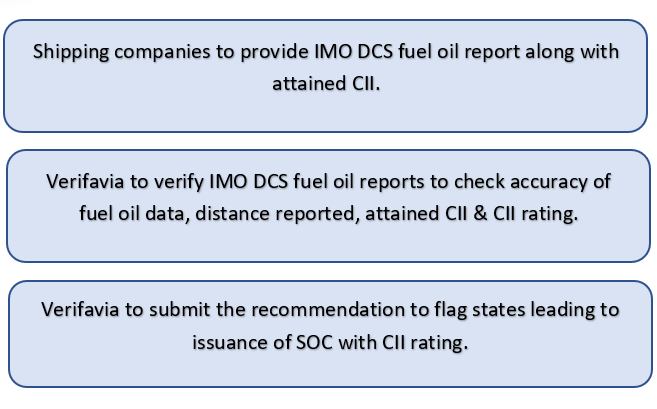Carbon Intensity Indicator (CII)

Carbon Intensity Indicator (CII) is a new measure based on an operational approach that supports the IMO’s objective "to reduce CO2 emissions per transport work, as an average across international shipping, by at least 40% by 2030, pursuing efforts towards 70% by 2050, compared to 2008."
Resolution MEPC.328(76) adopted at MEPC 76 in June 2021, entered into force on 1 November 2022 and introduced amendments to MARPOL Annex VI with new requirements for:
- Operational Carbon Intensity Indicator (CII) and CII rating (Regulation 28)
- Enhanced SEEMP (Regulation 28)
What are the Annual operational carbon intensity indicator (CII) and CII ratings?
CII is the operational carbon intensity Indicator expressed in grams of CO2 per deadweight-nautical mile and it is a measure of vessel efficiency of CO2 emitted in transporting cargo or passengers. The CII and CII rating scheme will apply to all Cargo and Cruise ships of 5’000 gross tonnage and above, that is, the ships which are already subject to the requirements of the IMO Data Collection System (IMO DCS).
The annual operational CII achieved or attained CII will be required to be documented and verified against the required annual operational CII. This will enable the Flag state to determine the operational CII rating, the rating will be given on a scale from A to E, A being the better performing vessels.
The annual operational CII achieved or attained CII will be required to be documented and verified against the required annual operational CII. This will enable the Flag state to determine the operational CII rating, the rating will be given on a scale from A to E, A being the better performing vessels.
When will it come into force?
MPEC 76 held in June 2021 adopted various regulations on the determination of the required annual operational Carbon Intensity Indicator and, calculation and verification of the attained annual Carbon Intensity Indicator. After the 1st January 2023, each ship should calculate its attained CII every year, based on the annual fuel consumption and annual distance traveled which is collected under IMO DCS.
CII & enhanced SEEMP
The attained annual operational carbon intensity indicator will be based on IMO DCS. The revised MARPOL Annex VI Regulations 5.4.6 and 26.3 requires that for vessels, where the CII requirement is applicable, should have their SEEMP enhanced no later than 1 January 2023 to include:
- the methodology that will be used to calculate the ship's attained annual operational CII and the processes that will be used to report this value to the ship's Administration
- the required annual operational CII, as specified in regulation 28 of this Annex, for the next three years
- an implementation plan documenting how the required annual operational CII will be achieved during the next three years
- a procedure for self-evaluation and improvement
What does it mean for ship operators?
Since 2019 it has been mandatory for Ship Operators to fulfill the requirements of IMO’s data collection system. In this process they monitor Fuel consumption, Hours underway and Distance travelled within a calendar year, this data is then verified by an approved Verifier, they will additionally have to calculate the attained CII of each ship. Based on the attained and required CII, a CII rating will be given to a ship.
The required CII is calculated using 2019 as a baseline and a reduction factor will be applied every year from 2019 onwards, this means the ship will have to continuously perform better each year to stay complaint or to maintain a preferred rating. Assuming a ship is rated as C in the year 2021 and not able to sustain the rating, the rating will decrease if the operator does not continuously improve the operational performance of their ships.
More on Carbon Intensity Indicator (CII)
- Required CII rating is calculated using the CII reference lines for each ship type and a reduction factor is applied every year.
- Administrations, port authorities, and other stakeholders, as appropriate will be encouraged to provide incentives to better rated ships. For ships operating continuously for three years at Level “D” or for one year at level “E”, an improvement plan will have to be submitted and implemented, which outlines improvement to the vessel's efficiency to a moderate level rating “C” or above.
- The methodology for calculation of CII will be enhanced with the introduction of correction factors in a separate guideline which is expected to be adopted in future.
What can VERIFAVIA do for ship Operators?
Verifavia Shipping is the world's leading independent carbon emissions verification body for shipping under the EU MRV and, the IMO DCS registered with the Panama Maritime Authority, the Liberia Maritime Authority, and several other Flag States.
CII ratings will be based on verified reports of IMO DCS, our experience in the verification of carbon emissions allows for the seamless addition into our verification process for IMO DCS.
CII Dashboard
Verifavia Shipping, with its unique in-house CII dashboard, can assist ship owners and operators to evaluate vessel's current and future CII ratings. The dashboard also incorporates a CII calculator to forecast the operational efficiency of a ship, for a voyage or a over a given period.
3-step delivery process

Learn more:
> CII & CII dashboard Service
> Verifavia's IMO DCS verification services
> About Verifavia's authorization from the Liberia Maritime Authority
> About Verifavia's authorization from the Panama Maritime Authority





